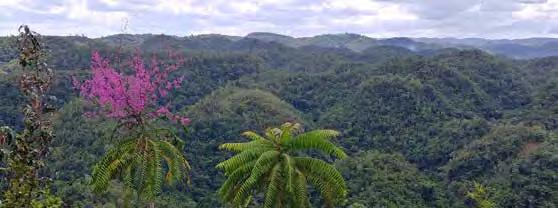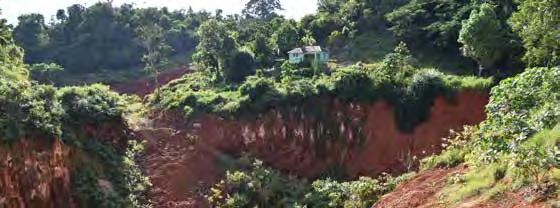
6 minute read
Quest for Ecological Justice in the Caribbean
from USPG Koinonia Issue 3 2020
by USPG
By Elizabeth Thomas-Hope
PROFESSOR EMERITA OF ENVIRONMENTAL MANAGEMENT, THE UNIVERSITY OF THE WEST INDIES.
We cannot fail to be aware that a global ecological crisis is upon us, with climate change providing the space and platform for the loudest articulation of the need for ecological justice. Foremost in the public narrative are demands for the sustainable use of the environment, not just for the present generation but more so for the generations to come.
Therefore, the issue of justice is not solely one of distributing environmental benefits and risks in the present, but doing justice to nature to allow the sustainability of natural capital and the protection of irreplaceable resources. The knowledge that the Earth is finite, and comprised of interconnected systems with thresholds of degradation beyond which restoration is irreversible, is now widely accepted. The central message is that nature has an intrinsic or inherent value and that humans are part of nature, not separate from it, so that justice for the one is also justice for the other. Climate justice is a major concern in the Caribbean, as elsewhere, representing just one of many - the Cockpit Country. Over 500 square miles of forest
situations where ecosystems are “traded” for economic activities without limits to resource exploitation or concern for either sustainability or justice.
The Caribbean
Formerly pristine ecosystems of the Caribbean were dramatically and irreversibly altered from the mid-17th century as commercial profit from tropical products, principally sugar, drove European colonial expansion in the region. This was associated with the aggressive clearing of forests undertaken by slave labour. Beyond clearing for cane and other crops, the plantations placed demands on trees for all construction needs. Additionally, huge quantities of wood fuelled the furnaces for sugar extraction. With timber removed, soil erosion was widespread. Had restraint been exercised in this process, the story would have been multinational company. A compromise was struck and
different. But the reality was the transformation of multi-species island ecosystems into monoculture plantations for massive profit. Then, when competition and production costs increased and profits waned, the abandoned acres were left as reminders of a past age of prosperity – not for the Caribbean, but for Europe. Several small Caribbean islands were entirely deforested while, in the larger ones like Jamaica, the alluvial plains and low-lying lands were cleared leaving the interior uplands, no good for sugar-cane, generations of small farming communities. But by the mid-20th century, the interior was in demand for mining bauxite (the ore from which aluminium is derived). Multinational bauxite companies acquired large tracts of land, mandating the relocation of settlements that were in their way. Once areas were open-cast mined they too became abandoned and of minimal use for agriculture afterwards. The heyday of bauxite left Jamaica’s economy as unsustainable as sugar had done before, as dependent as ever on the outside world, and locked into ongoing indebtedness to international banks. In recent years we have seen new proposals for bauxite mining, this time including the last of Jamaica's contiguous rainforests of the interior upland on limestone rock characterised by caves, swallow holes, conical hills and deep valleys defended by the 18th century Maroons (runaway slaves) that took refuge there, is still home to Maroon communities. Based on previous experience, the 'cost' of bauxite mining in the Cockpit Country would include deforestation, loss of biological diversity, water, air and soil pollution, the risk of ill health of residents in nearby villages from caustic dust, the destruction and ¬displacement of intact, viable rural communities and the loss of local agricultural production and way of life associated with such communities. Driven by the present national environmental awareness and ethic, the response was in stark contrast to the earlier situation. Caution has been exercised by the government, and a strong stand taken by local residents and ecological groups across Jamaica opposing the issuing of contracts to the
as the refuge of ex-slaves and locations for successive the Cockpit Country Protected Area was designated (2017). However, this would not protect ecosystems, rivers, watersheds and settlements in an adjoining area that still remains in contention.
ISSUE 3 2020

Jamaica
At a critical meeting of stakeholders, a commentator noted that, “Maroon drumming and singing called the ancestors into the space and made it sacred.” But the mainline churches were neither there, nor otherwise expressing any view on the matter. The church, anxious to avoid a highly politicised issue, has remained silent, accepting the view that it was solely one of “economic development”. The implications for ecological justice were missed.
The Church and the quest for ecological justice
Restoration is an ancient Judaeo-Christian tenet. But interpretations have been guided by the view that it was only God’s temple and His people that were to be restored, not His natural creation. Restoring nature as a divinely-inspired principle emerged in the public arena through the first Earth Day in the USA (April 22, 1970). The 20 million participants across the country protested against DDT, pollution, and all forms of environmental degradation. They rejected the frontier ethic that had gutted and then abandoned worn-out lands, and sought a collaborative ethic making nature humanity’s partner, rather than victim. A just and compassionate future, if not sheer survival, required a much more considerate stewardship of natural capital. Along similar lines, the Anglican Consultative Council in 1990 identified “Striving to safeguard the integrity of creation and sustain and renew the life of the Earth” as The Fifth Mark of Mission. While the response has been a general recognition that nature should be respected, zeal for its connection to justice is lacking. The international dimension of the quest for ecological justice speaks to the evidence that the Earth’s dominant economic, social and political systems have been based on an unequal NorthSouth distribution of power and wealth. This has led to ecosystem destruction, pollution, species extinctions and climate change threatening both the Global North and South, but impacting most negatively the more economically vulnerable populations in the South. From a spiritual perspective, ecological justice is based on the belief that the Earth is sacred, and that it has become a victim of exploitation as also have vulnerable human communities. There is need for a renewed emphasis in our interpretation of Scripture to reveal its calls for ecological justice based on our responsibility for the marginalized and exploited - both human and non-human in relationship with each other. But built into the human psyche, is a deeply embedded dualism between mind and body, spirit and flesh, domestic and alien, this world and the next, conscious humans and non-thinking things of nature. The Judeo-Christian interpretations of Scripture in the past have been criticized for reinforcing this dualism by portraying a transcendent God as separate from the world, and humans in the image of God with dominion over nature, as being superior and separate from Earth. Ecological justice, then, countering dualism by expressing the unity of social and environmental dimensions of community, provides an expansive lens for properly seeing relevant and everchanging contemporary issues. It is suggested, therefore, that the quest for ecological justice requires further conversations about how, as a paradigm of justice, it could contribute in dynamic and various ways to building a more just society and a sustainable future for everyone. ■

Bauxite extraction










